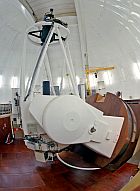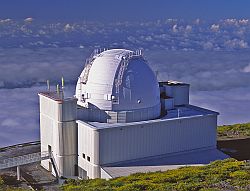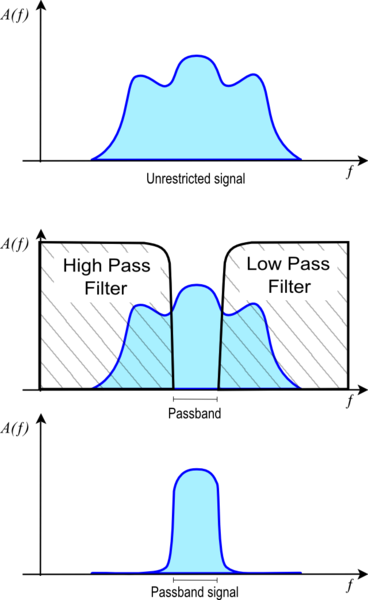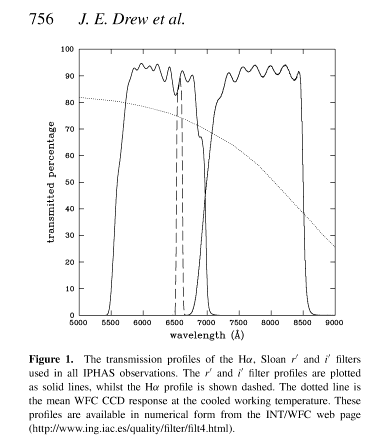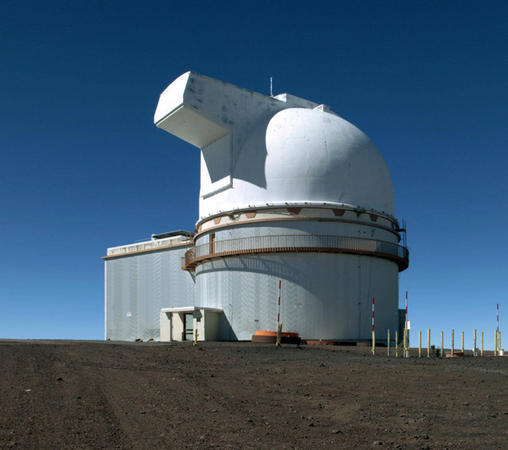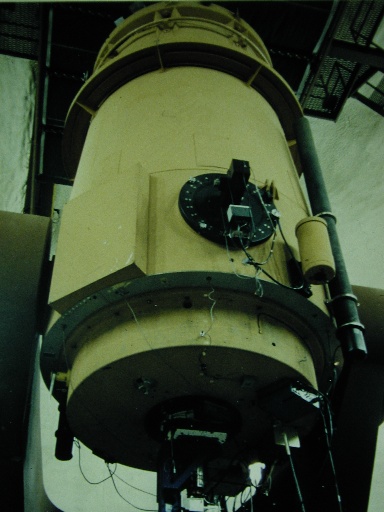Summaries and questions on discussed papers
Contents
- 1 Barensten 2011 T Tauri candidates and accretion rates using IPHAS:method and application to IC 1396
- 2 Nakano 2012 Wide-Field Survey of Emission-line Stars in IC 1396
- 3 Getman 2006 X-Ray Study of Triggered Star Formation and Protostars in IC 1396N
- 4 Beltran 2009 The stellar population and complex structure of the bright-rimmed cloud IC 1396N
- 5 Original SFO - Sugitani et al 1991
- 6 Most recent paper - Ogura et al 2002
- 7 Info to help you answer questions and things I just don't get
- 8 Spitzer Observations of IC 2118: “Witch Head Nebula”
- 9 New Young Star Candidates in the Taurus-Auriga Region as Selected from WISE
- 10 New Young Star Candidates in CG4 and Sa101
- 11 "Triggered Star Formation and Evolution of T-Tauri Stars in and Around Bright-Rimmed Clouds" by Chauhan, et al. and "Triggered Star Formation and Young Stellar Population in Bright-Rimmed Cloud SFO 38" by Choudhury, et al.
Barensten 2011 T Tauri candidates and accretion rates using IPHAS:method and application to IC 1396
- INT is Isaac Newton Telescope (100 inch mirror) in Canary Islands, Spain.
- The survey uses two broad-band filters and a narrow H-alpha filter to obtain deep images of nebulae in our Galaxy and for identifying rare types of stars.
- T Tauri star was discovered in 1852 to be a variable star.
- Today we know it is 100 million years old and 460 LY away.
- T Tauri stars were proposed to be YSOs in 1957.
QUESTION: What is the best way to describe any differences for T Tauri stars and YSOs?
This study:
- Looked for T tauri candidates and accretion rates using IPHAS (r, i, Halpha); over the entire huge IC1396 complex where BRC 34 & 38 are located.
QUESTIONS: What are the Sloan r' and i' filters exactly? Are they different wavlengths--red and infrared? Does it help measure the infrared excess? Do they measure a specific element characteristic? E.g.; H Alpha wavelength is 656.28 nm when an electron orbit 3 falls 2nd orbit level.
I found a good web explanation on filters and a picture here: http://en.wikipedia.org/wiki/Passband
ANSWER FROM LUISA: what you found here is signal filters, not wavelength filters per se. What your figures look like to me corresponds to a discussion of electronic filters, e.g., finding an audio signal among hissing white noise. More on filters and bandpasses is the wiki page I assembled during an earlier week of Journal Club in which someone else was asking about filters. In answer to your specific question about what are the Sloan r' and i' filters exactly, see the figure on the right, which comes from Drew et al. 2005, MNRAS, 362, 753. They are two different optical bandpasses. The Halpha narrowband filter measures the Halpha line and little else. The broadband filters integrate over a wide enough bandpass that they catch a lot of lines.
QUESTION: Is this basically an optical (emission-line) study?
- Has data tables of 158 objects they think are young stars--out of one million objects.
- C-WAYs need to incorporate what they found -- mainly brc 34 (cloud D) and 38 (cloud E), PREVIOUS SUMMARY: need to email these guys and ask for source lists at least in these regions.
- For target validation, it includes some 2 MASS and Spitzer data but only for T Tauri candidates, or possibly only in the center of the complex?
This study found:
- Evidence that the hot O star HD 206267 triggered star formation; find increasing accretion rates, disc excesses and younger ages as move away from the hot blue star. Study cites Choudhury 2010 and Getman 2007 in this regard.
- Figure 9, page 11, is a great picture showing the hot big star (mother star) surrounded the young stars (all her baby stars). The infants are way out at the edge of the circle.
QUESTION: This is still debated, correct?
GOOD SUMMARY on MASSIVE STARS--aka MOM STARS: It is often claimed that radiation and stellar winds from O type stars may have a profound effect on nearby star formation. On one hand, a massive star may disrupt star formation by dispersing the local molecular cloud and removing circumstellar material from newly formed stars (UV photo-evaporation, e.g. Johnstone et al. 1998).
On the other hand, expanding ionization fronts may act to compress the gas around the periphery of an Hii region which then collapses to form stars (collect and collapse, Elmegreen & Lada 1977),or trigger star formation in a pre-existing cloud (e.g. radia- tively driven implosion, Kessel-Deynet & Burkert 2003).
This section 8.21 goes on to note:
While the effect of photoevaporation has been observed using direct imaging (so-called proplyd objects, O'dell et al.1993; O'dell & Wen 1994), a proof of triggered star formation is harder to obtain. Merely observing the presence of young stars in molecular clouds near hot stars is no solid evidence, because it is not clear whether the birth of the stars was triggered by the hot star, or whether stars were forming in these clouds regardless. Moreover, photoevaporation may act to disperse the circumstellar environment of protostars as a function of their distance, and therefore introduce an apparent evolutionary gradient which may incorrectly be interpreted as an age gradient (e.g. discussed by Beltr�an et al. 2009). The relatively simple nature of IC 1396, where the UV radiation field is dominated by the massive star system HD206267 (O6.5V), makes it a good region to study the influence of a hot star.
- They basically find that photoevaporation is perhaps only effective at removing disks within �1 pc from the radiation source and the age gradients prove true beyond that distance?
QUESTION: Can this be explained further? "The strongest argument in favour of triggered star formation comes from the dispersal of objects in front of (BRC) clouds A/B/E, shown close-up in Fig. 18. The clusters of our candidates in front of the ionized rims are significantly more dispersed than the embedded Class 0/I protostars inside the clouds, covering an area which is roughly 1 to 2 pc larger in diameter."
COOL NOTE: Evidence suggests our Solar System formed near a massive star! (e.g. Hester & Desch 2005).
- Telescope measured the ages, masses and radii of the young stars and from that concluded the mass accretion rates introduced by DeMarchi 2010.
COOL FACT: Mass accretion is thought to take place along magnetic field lines which act as channels connecting the disc to the star. The infalling gas is essentially on a ballistic trajectory, falling on to the star at close to free-fall velocities,producing a hot impact shock. The energy released in these shocks heats the infalling circumstellar gas, resulting in the broad H� emission lines seen in classical T Tauri stars. This implies that the measured line luminosity LH� may be used to estimated the accretion luminosity and subsequently the mass accretion rate.
- Tripled the number of classical T Tauri stars compared to previous searches by Sicilia-Aguilar et al.
(2005, 2006a). 56 percent are at low masses and less than 500,000 years old.
QUESTION: In section 7.1 on Non-systematic uncertainties,what is the Monte Carlo approach? And Gaussian noise? How are they used to measure extinction?
Nakano 2012 Wide-Field Survey of Emission-line Stars in IC 1396
University of Hawaii 2.2-m (87 inch) telescope on Mauna Kea using the Wide Field Grism Spectrograph 2.
Highlights of the Paper:
- Survey of emission-line stars in the IC 1396 H II (H2) region
- Calls YSOs (or T Tauri stars-TTS?) pre-main sequence (PMS)stars.
- Found 639 H-alpha emission-line stars
- Area was 4.2deg2 and their i′-photometry was measured.
- Spatial distribution shows aggregates near the elephant trunk globule (Rim A) and bright-rimmed clouds at the edge of the H ii region (Rim B and SFO 37, 38, 39, 41), and near HD 206267.
- Did not find any H alpha PMS stars in SFO 38 (BRC 38), but Choudhury (2010) found 45 YSOs in and around
SFO 38. "Of these, 26 sources are Class-0/I, Class-I, and Class-I/II, but there are no such objects situated outside the ionized rim. It follows that the birth of low-mass stars associated with bright rims appears to be the primary mode of star formation in IC 1396 at present."
- Young low-mass stars, which probably formed by a triggered mechanism in the BRC region, contribute a fraction of the mass of stars in IC 1396.
- Chose PMS stars based on extinstion estimate from the near-infrared (NIR) color–color diagram.
- Age and mass of these stars were derived from the extinction corrected color-magnitude diagram and
theoretical pre-main sequence tracks. (Most have ages less than 3 million years and masses of 0.2–0.6 mass of the Sun.A few stars are less than a million years old.)
- Compared emission stars with the Two Micron All Sky Survey (2MASS).
- Compared results to MIR All-Sky Survey obtained with the infrared camera (IRC) on board the AKARI satellite.
- Results may suggest that massive stars were born after the continuous formation of low-mass stars for 10 Myr. The birth of the exciting star could be the late stage of slow but contiguous star formation in the natal molecular cloud.
- Radiation-driven implosion may have triggered star formation--after the formation of HD 206267.
- HD 206267 was likely born in the central part after the continuous low mass star formation.
QUESTION: HD 206267 formed 3 million years. Does the hot O star form first and then trigger star formation. Or are some YSOs formed nearby beforehand and then the star accelerates the star forming process?
- Figure 1, page 31, shows where BRC 34 & 38 are located in their study. Paper states that BRC 38 is much more active forming stars but does not say exactly how many of the 639?? It says "Note. — Table 2 is published in its entirety in the electronic edition of Astronomical Journal. A portion is shown here..."
FROM OUR PREVIOUS SUMMARY: We need to: "read this in some detail, and scavenge the data in the regions we care about (BRC 34 and 38)."
DEFINITION: Coeval: Two stars thought to be coeval because they have nearly the same mass and brightness.
DEFINITION: Viriral: The virial theorem provides a general equation relating the average over time of the total kinetic energy.
REMINDER DEFINITION: (from wiki) In astronomy, color–color diagrams are a means of comparing the apparent magnitudes of stars at different wavelengths. Astronomers typically observe at narrow bands around certain wavelengths, and objects observed will have different brightnesses in each band. The difference in brightness between two bands is referred to as color. On color–color diagrams, the color defined by two wavelength bands is plotted on the horizontal axis, and then the color defined by another brightness difference (though usually there is one band involved in determining both colors) will be plotted on the vertical axis.
NOTE: It would help if figures were placed within the text.
COMPARISON to BARENSTEN: Out of 143 PMS candidates identified by Barentsen, 119 stars are in common with our HII sample. For the PMS candidates including smaller EW ( > 10 °A ), the fraction of recovered sources by Barentsen et al. (2011) falls off to 50%.
On the other hand, the fraction of recovered sources with EW > 10 °A maintains 86% (51 out of 59) in our sample. We confirmed that none of their rejected candidates ( 30 stars ) by Barentsen were included in our list. Thus, our observations are more sensitive than their survey for the emission-line stars with small H alpha equivalent width.
ACRONYMS: Great list: http://en.wikipedia.org/wiki/List_of_astronomy_acronyms http://www.all-acronyms.com EW = Equivalent Widths CTTS = Classical T tauri Stars WTTS = Weak-line T tauri Stars
QUESTION: What is the AeBe in HAeBe stars? Herbig Ae/Be (HAEBE) stars are pre main-sequence stars of intermediate mass (2 to 9 solar masses). With masses between those of low-mass T Tauri stars and high mass young stars, HAEBE stars fill an important parameter space in addressing the question of star formation as a function of mass.
Found this Powerpoint when researching:
http://www.google.com/url?sa=t&rct=j&q=ysos%20tts%20pms&source=web&cd=3&ved=0CFUQFjAC&url=http%3A%2F%2Fhomepages.spa.umn.edu%2F~pedmon%2FT%2520Tauri%2520Stars%252012-05-05.ppt&ei=fC21T9aPFsWigweTmIjeDw&usg=AFQjCNHna3ure4nC6BQe5irp9V8wT0yyJw
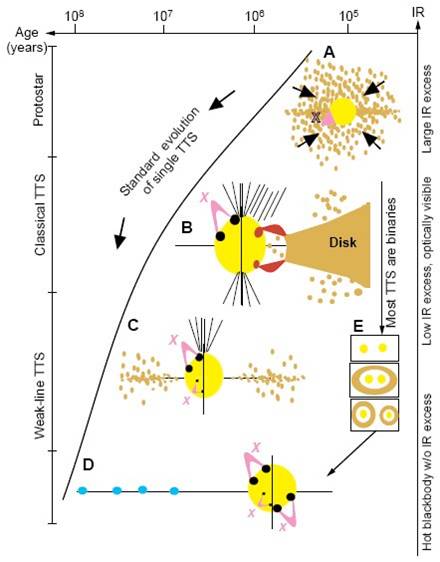 Diagram on YSO evolution from powerpoint
Diagram on YSO evolution from powerpoint
Young Stellar Objects are:
- Objects contracting out of a molecular cloud
- Pre-Main Sequence (PMS)
- Go from Contraction to Convection to Radiation
- Time scales to reach the Zero Age Main Sequence (ZAMS) vary depending on Mass of Star
T Tauri Stars are:
- A subclass of YSO’s
- CTTS mark the change from Gravitational Collapse to Internal Convection of the Protostar
- WTTS mark the change from Convection Transport to Radiation Transport
- WTTS also mark when Hydrogen Fusion become dominate in a Protostar
- Need better understanding of the disk and jets are needed to fully understand T Tauri Stars
- T Tauri Stars give insight to how our Sun evolved on to the Main Sequence
Getman 2006 X-Ray Study of Triggered Star Formation and Protostars in IC 1396N
An observation of IC 1396N with Chandra, so X-ray light. How long (total time) was the observation? 30 ks = 30 kilo seconds = 30,000 seconds = 500 min = 8.33 hours - Is this a long observation? I got the impression from the reading that it was short.
Intro - What will be useful in this section for us?
The cometary globule this study looks at is BRC 38?
Nice list of indicators of star formation in IC 1396N. Things we should know about
-IRAS source 21391 +5802
-H2O masers
-molecular outflows
-HH flows
-clusters of IR embedded sources
-radio mm portostars
Explanation of RDI - easy to understand. Explanation of why an x-ray study - I was surprised. Didn't think about magnetic fields being active in YSO.
"2.1 - 2.3 Chandra Observation & Source List - The meat for us!"
The most important things here are the tables and figures. Locations given for the found sources and correlations to 2MASS. Will we eventually understand what each of these columns mean?
2.1 - Interesting that 8 corrections were made to the data. EIGHT pg 317-8 Data reduced to 117 point sources (listed in table 1); 66 of those correlated with 2MASS; 5 newly identified
Sections 3, 4 & 5 - Interesting things about IC 1396N
3.1-3.4 Data reduced to sources coming from star formation. 25 sources are probable members of the globule. Sources classified as class 0, I, II, III.
4.1- 4.3 It was interesting that there was flaring going on. Are YSO variable in the their light output, like a variable star? 4.3 was hard to understand. I have to sort out wavelengths and energies associated with each em light band.
5.1-5.3 Figure 10 a - This is a great picture of results of using different types of observations and even of resolution. Why correlation with other studies is needed. Figure 10 c - Source 66 and 68 are so much brighter than the others. Interesting. It was also interesting that #66 is the brightest x-ray object in IC 1396N. What does it mean that it is 'one of the most heavily absorbed sources'?
Questions
1. Does this symbol mean of the Sun? M⊙ = mass in relation to the Sun?
2. What is IMF - initial mass function? pg 328, last full paragraph
3. What is MedE? pg 331 5.2
4. What is intervening column density? pg 332 5.3 2nd paragraph
5. What is extinction? pg 332 5.3 3rd paragraph
"Section 6 & 7 - Science questions and summary"
Section 6 pulls the info from the study into the larger science questions - What do these results say about triggered star formation and the two initiation methods mentioned? It seems that RDI (radiation driven implosion) is supported.
I like section 7's summary. Easy to understand and I like the list of classifications of the 25 YSO.
Beltran 2009 The stellar population and complex structure of the bright-rimmed cloud IC 1396N
This article discusses the structure of this cloud and gives positions of everything it talks about. 18 pages worth of tables! Their conclusions are also different than the previous paper about star formation.
I found it interesting that individual sources we read about in the previous article have been resolved into several sources by the time this one was written.
Questions
1. They mention that bluer YSO mean older and redder are younger -- this is opposite of main sequence stars
2. What is on source images and off sources images? Why do you do this? this is to try and adjust for background light
The images went through 5 set of corrections or adjustments before photometry
3.2 The authors conclude not all star formation is triggered star formation in this cloud. Then what else is there?
3.3.1 All this info about H2 knots. Dense material. Does the red and blue shift indicate spinning? No, it is looking at a jet face on but not perpendicular
3.3.2 H2 flows are complicated. A lot of assumptions are made.
4. 736 sources found in all three bands - J, H K' 128 sources found only in HK' 67 sources found only in K' 79 sources found only in JH
Different conclusions from Getman. An age gradient is not found in the south-north direction of the globule; not all star formation in globule is by triggered star formation. NO alternative method given.
Original SFO - Sugitani et al 1991
Survey of BRCs to describe the BRCs themselves and look for YSOs.
Palomar Sky Survey (PSS) and IRAS point sources.
44 BRCs found in Palomar Sky survey prints that had associated IRAS point sources where all found to have IRAS point sources that were good candidates for being YSOs. Tables/images exist for; HII region locations, PPS finding charts, BRC location charts, IRAS point source properties (12, 25, 60, 100 micron), BRC and point source descriptions and plots.
Questions to ask yourself as you read
Abstract, Intro and Summary
-what is the flow of all the types of nebulosity that they describe and the cause/effect relationship to star formation?
-how will the understanding of this cause/effect help us in our closer study of just three BRCs?
The Sample, Results
-how did the authors take advantage of Palomar Sky Survey Prints?
-how will this help future astronomers with their work?
-table 3 lists exactly one IRAS source for each BRC, where are the rest of the YSOs we expect to see?
Discussion
Although 15 of the IRAS point sources were catagoized as type I and “really are” YSOs, why are all 44 of the sources considered good candidates for YSOs?
Most recent paper - Ogura et al 2002
Looking for H-alpha emissions using grism spectroscopy to find previously undetected YSOs that do not have strong IR excess in order to collect more information on star formation in BRCs and contained HH objects, and further investigate small-scale sequential star formation (SSSSF).
Optical (H-alpha using grism spectroscopy), 2 MASS
Questions to ask yourself as you read
Introduction, Observations and Data Reduction
-why do the authors recommend higher resolution studies?
-what is SSSSF and what is the evidence for supporting this hypothesis?
-what is grism spectroscopy and how does it help “fill in some holes” in terms of YSOs?
-how did the authors categorize H-alpha equivalent widths in “difficult cases”? Think about the usefulness of this data.
Images and Data
-what qualitative and quantitative information will be helpful to us in our study? List tables and images, highlighting information specific to our study.
H-alpha stars, HH objects and Discussion
-what did the authors find of interest in our particular BRCs?
-what evidence is given to support further multi-wavelength studies searching for YSOs?
Info to help you answer questions and things I just don't get
Data provided in 2002 paper - observation survey regions, dates, and exposure times; IRAS associated BRCs; H-alpha stars by BRC (BRC 27 (32 stars), 34 (2 stars), 38 (16 stars)), location, H-alpha EW, comments; H-alpha EW distribution; Finding charts (BRC 27 (chart k), 24 (chart o), 38 (chart q)); HH objects location and emission line intensities(BRC 38 only, 9 HH objects, data for 2); HH finding charts (BRC 38 only, chart d)
OB stars are hot, massive, short lived stars that emit enormous amounts of UV which ionizes surrounding interstellar gas forming HII regions and providing ionization/shock fronts to trigger star formation. HII (H-two) regions are large, low-density clouds with large amounts of ionized atomic hydrogen and other gases. HII regions can be the birthplace of thousands of stars over millions of years until supernova explosions and stellar winds from massive stars disperse the remaining gas and leave behind a cluster (i.e. Pleiades). Bok globules are dark dense clouds within HII regions, the result of formation of multiple star systems (can contain many young stars) that contain molecular hydrogen, carbon oxides, helium and silicate dust. Cometary globules are Bok globules that have comet like tail (can contain many young stars BRCs (Bright Rimmed Clouds) are dense clumps of matter (can contain many young stars) in older HII regions which have been further compressed and illuminated and from which surrounding interstellar medium has been dispersed by UV radiation from nearby OB stars. The hypothesis of small-scale sequential star formation (SSSSF) has redder stars in a BRC closer to the head of the BRC, furthest from the OB exciting star – stars are born as the shock wave moves away from the OB star, the youngest stars are the furthest from the OB star. HH (Herbig-Haro) are short lived areas of emission nebulae from young stars (there are young stars nearby, possible still hidden in their cocoon), formed when material ejected from the poles of young stars collides with interstellar medium to produce visible light. Hot Cirrus sources are filamentary (like cirrus clouds) structure that can be seen in the IR, but when “hot cirrus sources” are detected in an HII region, they may be YSOs that have been contaminated at the long wavelengths by emissions from the HII region. Grism spectroscopy makes use of a prism/diffraction grating to allow light at a central wavelength to pass through. In this study a “wide H-alpha” of 6300-6750 angstroms was used. ???Author talks about JHK observations and two color diagrams, but I do not see data for this???
Spitzer Observations of IC 2118: “Witch Head Nebula”
Summary:
The Witch Head Nebula (WHN) is thought to be a site of triggered star formation. Observations in 7 IR bands using SST and 4 bands in optical yields IR excesses in 4 of 6 previously known T Tauri stars and discovery of 6 new candidate YSOs.
This article has a nice introduction that covers a bit of stellar formation overview due to 2 mechanisms: gravitational collapse and “triggered” from nearby events like supernova. The Initial Mass Function (IMF) and the star formation efficiency are supported by the inventory of YSOs formed in a cloud, which then supports closer study of the initial conditions of star formation.
A detailed comparison of the two formation mechanisms with respect to the IMF and stellar formation efficiency will assist with understanding the mechanics of star formation itself.
The data analysis section was highly detailed and technical. This section gave me the greatest comprehension challenge and also the greatest number of questions that require a bit more clarification.
The selection of YSO candidates focused on finding sources having an infrared excess characteristic of YSOs surrounded by a dust disk. A high source contamination rate was expected. Filtering mechanisms form the literature based on Spitzer colors were used to distinguish likely galaxies from likely members. Optical information was used to further winnow the candidate list.
Both color-color and color-magnitude diagrams from IRAC were used to select sources. 459 sources were identified having colors consistent with galaxies dominated by Polycyclic Aromatic Hydrocarbons (PAHs). 765 more sources having colors consistent with active galactic nuclei (AGN), only 27 sources are not flagged as background contaminants and have colors compatible with YSOs and with IRAC excess. The list of 27 sources not flagged as contaminants bears further scrutiny. 18 of the YSO candidates have magnitudes fainter than 12. As the brightness decreases, the probability of the object being background contamination increases.
The wealth of data allowed these data to additionally constrain the YSO selection. 18 faint sources all fall in the region occupied by main-sequence stars or background galaxies. The 9 remaining YSOs with magnitudes less than 12 all appear redder, near or above a 30 Myr isochrones. These are strongly suspected to be contaminants. The 9 brighter objects are included in the list of their (the authors) IRAC selected YSO candidates. There are restrictions imposed with the consequence that leads to a distance assumption that may be problematic. The details of this challenge appear in the bottom half of page 13 for further detailed description, should curiosity require investigation.
All 9 of the IRAC selected YSO candidates are seen at MIPS-24. There is a bit more technical justification about why seeing these candidates in MIPS-24 at one of the two distances proposed (~210 pc and ~440pc).
Most of the sources seen in the observations at 24 or 70 μm are foreground stars or background galaxies.
POSS and 2MASS and optical images for each candidate were used to verify that they did not appear extended in any of these bands. All YSO candidates passed the checks and appear to be point sources in all available bands.
The MIPS selection was technically detailed and the objects seemed to fall into either Class II or Class III with weak excesses. There appears to be three distinct groups of object: 1) objects of zero color (likely foreground or background stars), 2) objects that are faint and red (likely galaxies) and 3) objects that are bright and red (likely YSOs). There doesn’t appear to be any sources between the photospehric Class III and Class II objects. The chosen selection process may have gathered the YSO candidates into the group of brightest or reddest object, lending further support that the assertion of faint object being most likely background galaxies (bottom of page 14). Why is this so?? (ANS: to first order, galaxies are much further away, and thus fainter.)
There is a good amount of detailed description of how the candidates were sorted out from the other sources. From the list of 10 YSO candidates, six are new discoveries. One of the Class II T Tauri stars is a flat disk. The fit for the edge-on-disk candidate was not the same as for the non-disk candidates, since the slope changes significantly depending on whether the MIPS points are included in the fit for the edge-on disk. I think I’d like to understand the slope correlation a bit better…
All of the YSO candidates are located in the head of the nebula, the most massive molecular cloud of the WHN. The distributions lend further support o the assertion that the IRAC and MIPS selected bright object are likely YSOs. The expected YSO candidates for the regions further south were not found. Apparently the conditions in this region do not support substantial star formation. The head of the nebula is about 3 times more massive than any of the other clouds.
There is a nice explanation of at least two intertwined mysteries that enshroud the WHN. The distance to it, and the external source that is responsible for the surface sculpture, illumination and possible trigger mechanism. There is a nice explanation of how the possible two sources (the Trapezium and Rigel) at different distances could solve the mysteries. There are arguments for both explanations, and the conclusion is that there is no clear answer. GAIA (galactic mapping mission proposed to launch in 2013) highlighted text abovecould provide a definitive answer by deriving accurate parallaxes to some objects.
The conclusion for the work states that the inventory of YSOs and candidates has doubles as a result of using Spitzer data to search for objects with IR excess in the region. SEDs are used extensively to identify YSO candidates. If the region is a triggered star formation mechanism, then trends of age or mass as they relate to location may be established. Since there are so few objects, since the distance is uncertain and since the spectral types for most of these objects is unknown, this correlation cannot be done rigorously.
Additional follow-up spectroscopic data are needed to confirm or refute the YSO status for the six new objects.
The new edge –on disk candidate in particular warrants further study, since such objects are relatively rare.
GAIA will be needed to resolve the mystery of the distance to the WHN.
Questions:
What:
- I want to verify that I understand correctly that bands UVRcIc stand for: Ultraviolet, Visible, Red and Infrared, respectively. -- ANS: see More on filters and bandpasses
- Flat fielding issues -- ANS: part of the calibration process. each pix responds differently in the CCD, and so part of the calibration is to look at an evenly illuminated textureless surface ("flat") to remove the pix-to-pix sensitivity variations.
- 100 MJy/ sr -- ANS - MegaJanskys per steradian, e.g., surface brightness, flux density per solid angle on the sky. we will talk more about this later.
- Median boxcar filter -- ANS - smoothing function
- NaNs -- ANS- Not a Number, e.g., computer gags (like sqrt(-1)).
- UV RcIc see More on filters and bandpasses
- “real matches “ -- ANS - you will understand in time, young padawan. Basically, computer says they are a match. are they really?
- false source associations -- ANS - as abive.
- centroiding -- ANS - centering the aperture on the source.
- ELAIS -- ANS - name of another survey
- U and 70 micro meters -- ANS - micrometers = microns. see More on filters and bandpasses
- Optical Mv -- ANS - absolute magnitude.
- VLBA and VLBI -- ANS - radio telescopes
- mas/yr -- ANS - milliarcseconds per year, units of proper motion on the plane of the sky.
How and HUH? : - see text above as well…
- APEX portion of MOPEX -- ANS - just a part of the software package.
- Zero point used to convert flux densities to magnitudes -- ANS - you will understand in time, young padawan.
- …as a final check on our measurements. -- ANS - need context?
- …through observation of Landolt standards… Does this mean that the additional epoch was just for verification of data integrity? -- ANS - possibly. need a little more context.
- …deviate significantly from zero -- ANS - need more context.
Why?
- The data were further processed… -- ANS - need more context
- …we wished to add reddened stellar models to the plots… -- ANS - need more context.
New Young Star Candidates in the Taurus-Auriga Region as Selected from WISE
New Young Star Candidates in the Taurus-Auriga Region as Selected from WISE
Summary: WISE data is used to search for YSO candidates in Taurus from a 260 square degree patch of sky to encompass previously identified Taurus members. Near and mid IR colors are used to select objects with apparent IR excesses and incorporate other catalogs of ancillary data. There is likely to be contamination lingering in this candidate list, and follow up spectra are warranted.
Even though Spitzer is good at finding new young stars, some are located surprisingly far from the traditional location based on CO gas or IRAS dust maps. A 44 square degree survey of Taurus was done with Spitzer. It was found that any solely near and mid IR color selection was filled with contamination from galaxies and asymptotic giant brand (AGB) stars. The use of ancillary data was crucial to establishing a list of high quality new members of Taurus. WISE surveyed the entire sky; the depth of coverage in the Taurus region is somewhat degraded relative to regions of comparable ecliptic latitude due to Moon avoidance maneuvers. Since the cloud is only 140 pc away, both surveys (Spitzer and WISE) should easily detect legitimate Taurus members.
New Taurus candidates were selected with IR excesses using WISE colors with the Koenig et al method. There are three lists: 1) recovered young stars, 2) rejected objects, and 3) candidate new Taurus members.
A substantial multi-wavelength database was assembled for point sources throughout the Taurus region. Not every source has photometry at all bands due to variations in depth and spatial coverage among the surveys involved.
The WISE data acquisition and reduction are discussed in Wright et al, Jarrett et al and in the Explanatory Supplement to the WISE preliminary Data Release Products. Any sources with contamination and confusion flags were rejected, as were “DHOP” (what’s this? ans: see footnote in paper) characters.
There were about 2.38 MILLION sources. Signal to Noise Ratio (SNR) measurements were used to drastically shrink the catalog to about 7,000 sources. The SNR cut was used in W4 to limit the contamination. Since the contamination rate for any color selection is expected to be relatively large, ancillary data are crucial for culling the list to high - quality candidates. A rough total of about 2,000 contaminants per square degree were determined. Approximately 1,760 YSO candidates were obtained before imposing additional requirements (which were??? - ans: keep reading) that the SNR be >7 imposed on all four WISE channels reduced the number to 1,014.
Ancillary data were used to weed out contaminants from the list of potential YSO candidates. Only 27 sources on the list of potential YSOs found matches with SDSS spectra.
Of the 1,014 potential YSOs, 196 of them have matches to previously identified stars. 18 of these are listed as unconfirmed candidates in Rebull et al (2010).
Manual Inspection was used to sort objects into “likely contaminant” or “perhaps YSO” bins. The four criteria used to categorize were: 1) matching objects in SIMBAD, 2) matches to objects identified as contaminants in Rebull at al (2010), 3) matches to the 2MASS Extended Source Catalog, and 4) identification as extended in the SDSS pipeline. SEDs were then generated using all the photometric date in the database, and the SEDs were inspected. Based on experience, the SEDs were then categorized as still possible YSO candidates, or likely extragalactic objects. This process may have dropped viable YSO candidates similar to MHO-1 (huh?) or Haro 6-39 (huh? ans: these are both just names of objects). This process left about 130 candidates. The sources were identified as either being likely subjected to source contamination (HOW? - ans: you will learn, young padawan.) resolved as a likely galaxy (HOW?- ans: you will learn, young padawan.) or still apparently clean, point sources (HOW?- ans: you will learn, young padawan.) This brought the number of candidates down to about 94 objects. All SEDs for the 94 appear in the Appendix.
Projected location of the previously identified YSOs is generally highly clustered along the filamentary distribution of gas and dust, and the new objects are less clustered. The goal was to look for new YSOs outside the canonical groupings of previously known Taurus members. This could also be an indication of persistent contamination in the surviving list of YSOs candidates. There is more discussion about the location of previously identified YSOs and contaminants.
Previous YSOs are generally found in regions of high Av, and background galaxies are found in regions of low Av. The new objects are not particularly clustered, but not evenly distributed either. Most of the previously identified YSOs are bright and most of the contaminants are faint. The new YSO candidates span the range of bright and faint.
The list of objects by type: recovery of 196 previously identified young stars with IR excess, 686 likely to be galaxies, 13 foreground stars, 1 planetary nebula, 24 objects that are likely to be confusing and 94 new YSO candidates that are widely distributed in space.
Questions:
- What s the “J” in 2MASS J04360131 -- ANS: the same as whatever the "J" is in "J2000". Probably means "Julian" date.
- What is color near zero? -- ANS: difference of two magnitudes == color, so color = 0 means difference of two magnitudes is 0
- What is the reddening factor? -- ANS: see The influence of reddening
- What is the meaning of “...in the right regime for JHKs diagram” -- meaning it has the right colors to be a young star.
- What is “z measurement”? -- sorry, don't remember context for this.
- What are large inner disk holes? -- some disks may disperse from the inside out, e.g., the inner portions of the disk nearest the star get destroyed before the outer regions. disks caught in this stage have an inner disk hole. This can also be caused by the presence of planetesimals sweeping up matter (e.g., gaps in Saturn's rings).
New Young Star Candidates in CG4 and Sa101
The introduction to this paper also has some very good background about the Gum Nebula and the stellar formation mechanisms thought to apply within it. Previous studies by Reipurth and Pettersson are summarized, with a conclusion that stars associated with the Cometary Globule 4 (CG4) and Sa 101 are associated with the Gum Nebula. The distances to all considered objects are uncertain; the distances vary from 300 to 500 pc. The extrema of the distance estimates were tested, though the results are not strongly dependent on distance. The region contains previously identified young stars, so it is likely that there are more young stars of lower mass or more embedded than those previously discovered.
The data sections, like the other two papers summarized, are highly technical and summarizing all the details doesn’t seem fruitful beyond this very minimal overview. More detailed reading should be the way to get more detail about the data analysis.
For the IRAC data, two exposures were taken with three dithers per position. The two observational locations were reduced independently even though they overlap on the sky. Some of the very bright stars in the filed of view had instrumental effects that rendered the data very difficult to work with. There is quite a bit of detailed description of calibration technique, correlation and photometry and error reduction methods.
The MIPS 24 and 70 micron data were combined. The 24-micron data were affected by the bright objects and required additional processing. The background levels between the two observations were problematic, and a description of how this was addressed was discussed. Optimized data reduction to obtain brighter source measurements led to many sources fainter than the bright sources in the image being excluded from the catalog because the scientific goals are aimed at brighter objects. There is a good, technical justification of the filtering choices made to process the data.
The optical data used the observed Landolt (1992) standard stars of two or three fields several times per night for photometric calibration. For each target, aperture photometry was performed using multiple size apertures. There is a discussion of the correction used for a noticeable variation of the point-spread function (PSF) that is location dependent on the CCD.
The bandmerging of the photometric data was first merged from all four IRAC channels with the near IR 2MASS data for each observation. This was then merged together with the source lists from each observation. The MIPS data was then included, and then the optical data was merged. A very detailed discussion of how this was done follows.
YSO candidate properties are discussed in the subset of optical, near IR, B-band and SEDs. Optical data can greatly aid in the confirmation or refutation of YSO candidacy because they provide constraints on the Wien side of the SED. Objects with optical data that have already been ruled out as SOs based on the IRAC properties are all well below the 30 Myr isochrones scaled to 500 pc. Deeper optical data are desirable to obtain magnitude estimates for the remaining YSO candidates. The degree of reddening is difficult to estimate because the spectral types for most of the sources are not available. The candidates have infrared excess with a moderate degree of reddening. Young stars that are actively accreting from their circumstellar disks can have excess UV emission in the U or B bands or longer. These bands are also the most sensitive to reddening. Figure 13 is discussed with respect to mass accretion. The coordinates of the YSOs are listed in Table 1. The SEDs of the 22 YSO candidates are displayed in figures 14 - 16. A spectral type of MO was assumed for the remaining objects. A redden model of each object is shown and normalized to the Ks band where possible. These are presented as a guide to the eye rather than a robust fit to the object to allow the immediate IR excesses to be immediately apparent. There is quite a bit of more technically detailed description of the properties in the SEDs section than is summarized here.
There is a galaxy, ESO 257 – G 019 that is mentioned because it appears in the observation field. It has not been studied, and some basic astrometric data about it is listed.
In conclusion, 6 previously identified young stars were rediscovered. There are 16 new YSOs that were discovered and evaluated with ground-based data in the near IR from 2MASS to constrain the SEDs of the candidates. The new young star candidates were graded into confidence groups. Additional data will be needed, such as optical photometry where it is missing and optical spectroscopy to obtain spectral types.
I didn’t have any questions about this article.
"Triggered Star Formation and Evolution of T-Tauri Stars in and Around Bright-Rimmed Clouds" by Chauhan, et al. and "Triggered Star Formation and Young Stellar Population in Bright-Rimmed Cloud SFO 38" by Choudhury, et al.
File:Chauhan et al Reading Guide.pdf
File:Choudhury Guided Reading.pdf
